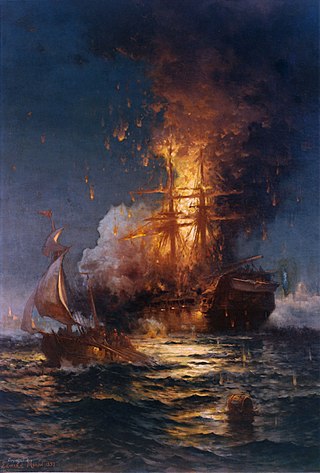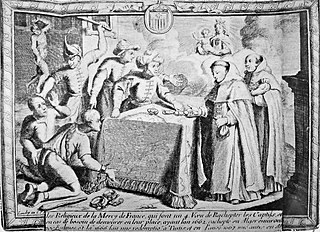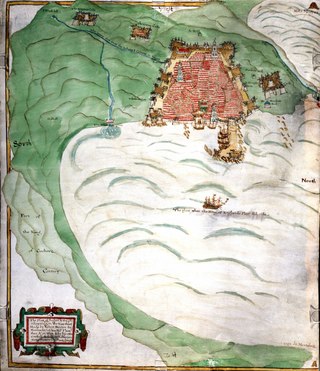
The First Barbary War (1801–1805), also known as the Tripolitan War and the Barbary Coast War, was a conflict during the Barbary Wars, in which the United States and Sweden fought against Tripolitania. Tripolitania had declared war against Sweden and the United States over disputes regarding tributary payments made by both states in exchange for a cessation of Tripolitatian commerce raiding at sea. United States President Thomas Jefferson refused to pay this tribute. Sweden had been at war with the Tripolitans since 1800.

The Barbary Wars were a series of two wars fought by the United States, Sweden, and the Kingdom of Sicily against the Barbary states and Morocco of North Africa in the early 19th century. Sweden had been at war with the Tripolitans since 1800 and was joined by the newly independent US. The First Barbary War extended from 10 May 1801 to 10 June 1805, with the Second Barbary War lasting only three days, ending on 19 June 1815.

The Second Barbary War (1815) or the U.S.–Algerian War was fought between the United States and the North African Barbary Coast states of Tripoli, Tunis, and Algiers. The war ended when the United States Senate ratified Commodore Stephen Decatur's Algerian treaty on 5 December 1815. However, Dey Omar Agha of Algeria repudiated the US treaty, refused to accept the terms of peace that had been ratified by the Congress of Vienna, and threatened the lives of all Christian inhabitants of Algiers. William Shaler was the US commissioner in Algiers who had negotiated alongside Decatur, but he fled aboard British vessels during the 1816 bombardment of Algiers. He negotiated a new treaty in 1816 which was not ratified by the Senate until 11 February 1822, because of an oversight.

The Barbary pirates, Barbary corsairs, or Ottoman corsairs were mainly Muslim pirates and privateers who operated from the Barbary states. This area was known in Europe as the Barbary Coast, in reference to the Berbers. The main purpose of their attacks was to capture slaves for the Barbary slave trade. Slaves in Barbary could be of many ethnicities, and of many different religions, such as Christian, Jewish, or Muslim. Their predation extended throughout the Mediterranean, south along West Africa's Atlantic seaboard and into the North Atlantic as far north as Iceland, but they primarily operated in the western Mediterranean. In addition to seizing merchant ships, they engaged in razzias, raids on European coastal towns and villages, mainly in Italy, France, Spain, and Portugal, but also in the British Isles, the Netherlands, and Iceland.

Occhiali was an Italian farmer, then Ottoman privateer and admiral, who later became beylerbey of the Regency of Algiers, and finally Grand Admiral of the Ottoman fleet in the 16th century.

The Bombardment of Algiers was an attempt on 27 August 1816 by Britain and the Netherlands to end the slavery practices of Omar Agha, the Dey of Algiers. An Anglo-Dutch fleet under the command of Admiral Edward Pellew, 1st Viscount Exmouth bombarded ships and the harbour defences of Algiers.

The action of 3 October 1624 was a naval engagement that took place near San Pietro Island, Sardinia, during the war against the Barbary corsairs. A squadron of galleys from the Spain, Grand Duchy of Tuscany and Papal States under Diego Pimentel engaged a squadron of six Algerian ships under Azan Calafate. The Algerians were defeated, their flagship was destroyed, and four ships were captured. Also, the Christian slaves they owned were freed.

The Regency of Algiers was an autonomous eyalet of the Ottoman Empire in what was known as the Barbary coast of North Africa from 1516 to 1830. It was an early modern tributary state founded by the corsair brothers Oruç and Hayreddin Barbarossa, ruled first by viceroys, which later became a sovereign military republic. The Regency was infamous for its Barbary corsairs, making it a formidable pirate base for maritime Holy war and plunder against Christian powers. It was also the strongest Barbary state. Situated between the Regency of Tunis in the east, the Sharifian Sultanate of Morocco and Spanish Oran in the west, the Regency originally extended its borders from the Mellegue river in the east to Moulouya river in the west and from Collo to Ouargla, with nominal authority over the Tuat and In Salah to the south. At the end of the Regency, it extended to the present eastern and western borders of Algeria.
Lambert Hendriksz was a Dutch vice admiral. He is usually referred to by his nickname, Mooy Lambert. Lambert served under Willem de Zoete and Jacob van Heemskerk, and was present as a rear admiral at the battle of Gibraltar. Lambert was active against the Dunkirk corsairs and in 1605 managed to defeat and capture the Dunkirk admiral Adriaan Dirksen.
Jan Janszoon van Haarlem, commonly known as Reis Mourad the Younger, was a former Dutch pirate who became a Barbary corsair in Ottoman Algeria and the Republic of Salé. After being captured by Algerian corsairs off Lanzarote in 1618, he converted to Islam and changed his name to Mourad. He became one of the most famous of the 17th-century Barbary corsairs. Together with other corsairs, he helped establish the independent Republic of Salé at the city of that name, serving as the first President and Commander. He also served as Governor of Oualidia.
This timeline of the history of piracy in the 1640s is a chronological list of key events involving pirates between 1640 and 1649.

The Barbary slave trade involved the capture and selling of European slaves at slave markets in the Barbary states. European slaves were captured by Muslim Barbary pirates in slave raids on ships and by raids on coastal towns from Italy to the Netherlands, Ireland and the southwest of Britain, as far north as Iceland and into the Eastern Mediterranean.
Siemen Danziger, better known by his anglicized names Zymen Danseker and Simon de Danser, was a 17th-century Dutch privateer and Barbary corsair based in Ottoman Algeria. His name is also written Danziker, Dansker, Dansa or Danser.

Hamidou ben Ali, known as Raïs Hamidou, or Amidon in American literature, born around 1770, and died on June 17, 1815, near Cape Gata off the coast of southern Spain, was an Algerian corsair. He captured up to 200 ships during his career. Hamidou ensured the prosperity of the Deylik of Algiers, and gave it its last glory before the French invasion. His biography is relatively well known because the French archivist Albert Devoulx has found important documents, including a precious register of prizes opened by the authorities of the Deylik in 1765. Songs and legends have also taken hold of this charismatic character.
The Battle of Cape Palos was a naval engagement that took place between 9 and 10 June 1758, during the Spanish-Barbary Wars. A Spanish squadron of three warships intercepted an Algerian squadron of two warships escorting a prize ship. After a prolonged fight, the Algiers flagship surrendered. His consort eluded the battle, but wrecked and the prize ship escaped. Algiers flagship sank from the damage, but there were several prisoners and Christian slaves released.

The French-Algerian War of 1681–1688 was part of a wider campaign by France against the Barbary Pirates in the 1680s.

The English Expedition to Algiers occurred between 1620 and 1621, it was a naval attack ordered by King James with the goal of ending Muslim piracy.

The ta'ifa of raïs or the Raïs for short, were Barbary pirates based in Ottoman Algeria who were involved in piracy and slave trade in the Mediterranean Sea from the 16th to the 19th century. They were an ethnically mixed group of seafarer, including mostly "Renegades" from European provinces of the Mediterranean and the North Sea, along with a minority of Turks and Moors. Such crews were experienced in naval combat thus making Algiers a formidable pirate base. Its activity was directed against the Spanish empire, but it did not neglect the coasts of Sicily, Sardinia, Naples or Provence. It was the Taifa which, through its captures, maintained the prosperity of Algiers and its finances.

The Dutch-Barbary War, also referred to as the Dutch-Algerian War (1618-1622), was a conflict that originated from the activities of Barbary pirates targeting Dutch vessels. In response to these attacks, the Dutch launched several expeditions aimed at putting an end to the attacks on Dutch vessels and safeguarding their ships. Ultimately, these efforts proved successful as both nations recognized the significance of peace in maintaining a prosperous economy.

The Corsair War (1620–1621) was a conflict between the English colonial Empire of James VI and I and the Republic of Algiers, governed by Khizir Pasha.















